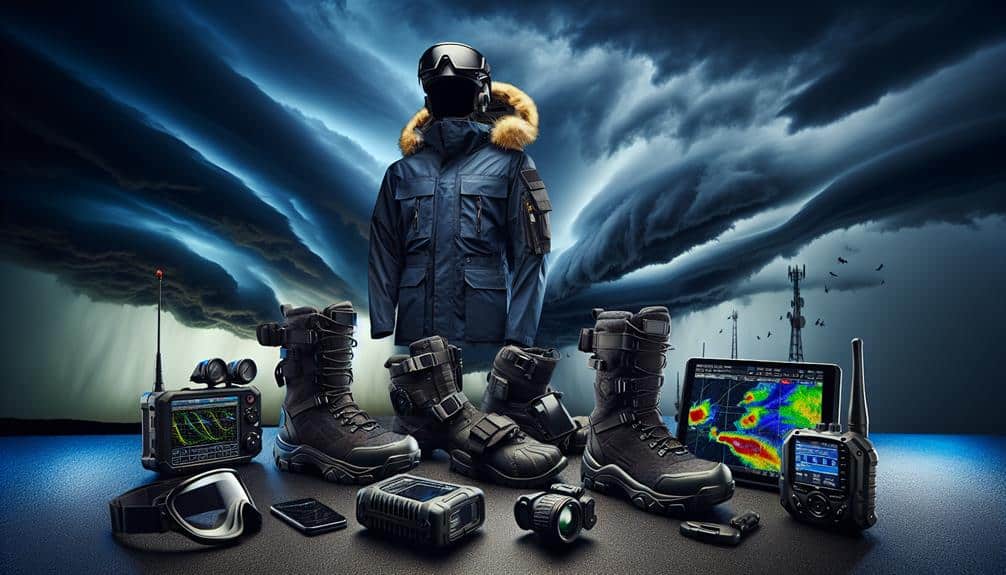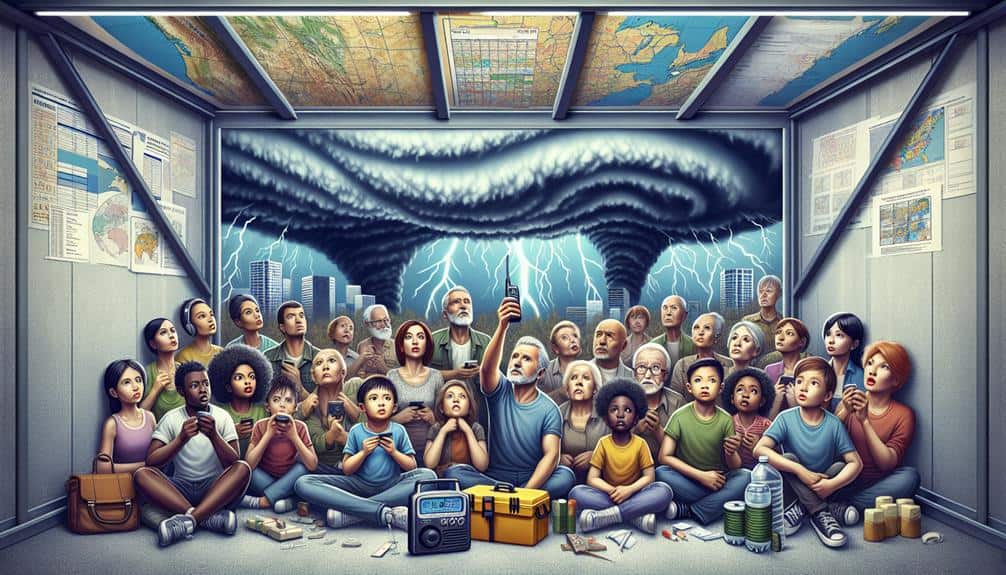As storm chasing professionals, we rely on essential gear to ensure safety and maximize data accuracy. Our kit includes high-resolution cameras like the Canon EOS R5, portable storm shelters such as StormSafe Pod, and sturdy tripods like the Manfrotto Befree Advanced. For precision tracking, we use GPS technology and Doppler Radar Systems, while satellite phones and two-way radios keep us connected in remote areas. Durable protective clothing and high-performance vehicles with reinforced suspensions are also critical. Additionally, we carry advanced data recording equipment and thorough safety kits. Explore further to uncover the detailed gear list we depend on.
Key Points
- High-Resolution Cameras: Capture detailed storm images with cameras like Canon EOS R5 or Nikon D850.
- Advanced Tracking Devices: Utilize Doppler radar systems, satellite imaging, and mobile mesonets for real-time weather updates.
- Reliable Communication Tools: Ensure uninterrupted communication with satellite phones and two-way radios.
- Durable Protective Clothing: Wear waterproof jackets, impact-resistant pants, and insulated gloves for safety.
Essential Storm Chasing Gear
For storm chasing professionals, having the right gear is necessary for both safety and effective data collection. We must prioritize our safety by selecting reliable emergency shelter options. Portable storm shelters, such as the Vortex Vault or the StormSafe Pod, offer robust protection against extreme weather. These shelters are engineered to withstand high winds and flying debris, providing a secure refuge until the storm passes.
Equally important is our photography equipment. High-resolution cameras like the Canon EOS R5 or the Nikon D850 are indispensable for capturing detailed images of storm phenomena. We should also consider wide-angle lenses to make sure we capture the full breadth of the storm's activity. Tripods with sturdy builds, such as the Manfrotto Befree Advanced, are essential for stabilizing our shots amid turbulent conditions.
Moreover, we need to pack additional batteries and memory cards to guarantee uninterrupted data collection. Weather-resistant camera cases will protect our gear from rain and dust, maintaining its functionality in harsh environments.
Advanced Tracking Devices
In storm chasing, advanced tracking devices are indispensable for operational success and safety.
We rely on real-time weather updates, GPS precision tracking, and mobile radar systems to provide accurate data and enhance situational awareness.
These tools enable us to make informed decisions rapidly as conditions evolve.
Real-Time Weather Updates
Real-time weather updates rely on advanced tracking devices that provide storm chasers with precise, up-to-the-minute data essential for making informed decisions in the field. These devices are indispensable for monitoring storm patterns, facilitating accurate weather prediction, and enabling effective storm interception. With real-time data, we're equipped to anticipate severe weather developments, enhancing both our safety and our ability to contribute to emergency response efforts.
Advanced tracking devices typically feature several vital components:
- Doppler Radar Systems: These provide detailed information on wind speed and precipitation, essential for predicting tornado formation and other severe weather events.
- Satellite Imaging: High-resolution images from geostationary satellites offer a broad view of weather systems, helping us track storm progress and development.
- Mobile Mesonets: These are vehicles equipped with meteorological instruments, allowing for in-situ data collection on temperature, humidity, and atmospheric pressure.
- Lightning Detection Networks: These systems pinpoint lightning strikes, providing data on storm intensity and potential danger zones.
GPS Precision Tracking
GPS exact tracking revolutionizes our ability to pinpoint precise locations, enhancing the effectiveness of storm chasing operations. With the advent of advanced tracking devices, we can now achieve unparalleled data accuracy, vital for both storm prediction and real-time response. These devices leverage satellite technology, guaranteeing that our positional data remains consistent and reliable, even in the most adverse weather conditions.
By integrating GPS exact tracking into our storm monitoring toolkit, we gain the ability to navigate with precision, minimizing risks and maximizing the quality of our data collection. This technology allows us to monitor storm movements with unmatched precision, which is essential for making informed decisions on-the-fly. Improved data accuracy from these devices not only aids in immediate storm prediction but also contributes to long-term climatological studies, enhancing our overall understanding of storm behaviors.
Moreover, the synergy between GPS exact tracking and satellite technology ensures our data remains robust and timely. This integration empowers us to operate with a high degree of freedom, knowing we can trust the accuracy of our positional data. As storm chasers, having access to such advanced technology is essential for maintaining safety and achieving our mission objectives.
Mobile Radar Systems
Mobile radar systems play a key role in our array of advanced tracking devices, allowing us to acquire real-time, high-definition data on storm structures and dynamics. These systems greatly enhance our radar precision and storm detection capabilities, offering vital insights that stationary systems often overlook.
By incorporating mobile radar systems into our operations, we gain the flexibility to position ourselves optimally for weather monitoring, regardless of the storm's trajectory.
The portable installation of these systems allows for swift deployment in various terrains, ensuring that we uphold the highest level of data accuracy. This adaptability not only enhances our storm detection precision but also streamlines our overall response time during severe weather events.
Key features of mobile radar systems include:
- High-Definition Imaging: Provides detailed visuals of storm structures, assisting in accurate analysis.
- Real-Time Data Transmission: Guarantees immediate access to essential information, facilitating timely decision-making.
- Portability: Simple to install and relocate, boosting operational flexibility.
- Advanced Algorithms: Enhances radar accuracy through sophisticated data processing.
In essence, mobile radar systems are indispensable tools in our pursuit of freedom and safety, offering unparalleled capabilities in storm tracking and weather monitoring.
Reliable Communication Tools
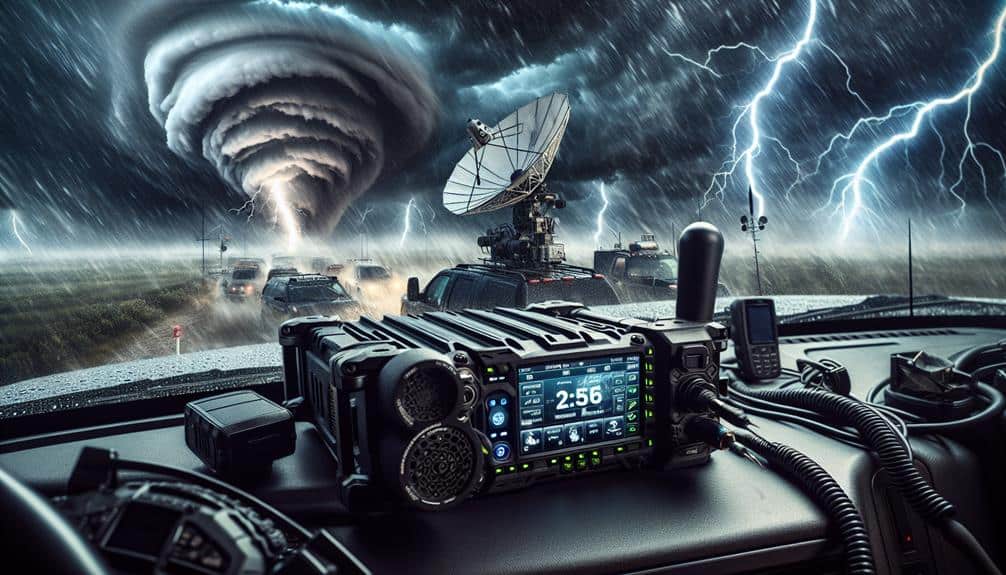
In storm chasing, reliable communication tools are critical for safety and coordination.
We'll focus on satellite phones and two-way radios, both of which guarantee uninterrupted communication even in remote areas.
Data shows that satellite phones provide 99.9% global coverage, while two-way radios offer instant communication with minimal latency.
Satellite Phones
Satellite phones provide storm chasing professionals with a crucial lifeline for reliable communication when traditional networks fail. In the face of severe weather conditions, maintaining contact with our team is non-negotiable. Satellite phones guarantee we can relay essential information, coordinate our movements, and receive emergency communication and weather updates in real-time.
When choosing a satellite phone, we should consider the following features:
- Global Coverage: Make sure the phone offers wide-reaching coverage, so we remain connected regardless of our location.
- Durability: Opt for rugged models that can withstand harsh environments, including extreme weather and physical shocks.
- Battery Life: A long-lasting battery is crucial for prolonged fieldwork during extended chases.
- Data Capabilities: Some satellite phones support data transmission, which is helpful for sending and receiving detailed weather updates.
Satellite phones enable us to operate autonomously and safely by providing a robust communication channel independent of terrestrial infrastructures. This capability is essential in our pursuit of capturing and understanding severe weather phenomena, ensuring that we remain informed, connected, and ready to respond to any emergency situation.
Two-Way Radios
For storm chasing professionals, two-way radios serve as essential tools for maintaining reliable and instantaneous communication across our team, especially when cellular networks are compromised. In high-stress environments where every second counts, these radios guarantee we stay connected for both operational updates and emergency communication.
Two-way radios excel in remote areas where signal strength from cellular towers is weak or nonexistent. They operate on dedicated frequencies, providing clear, uninterrupted communication channels. This capability is vital when we're tracking severe weather patterns and need to relay real-time data swiftly. We can also configure these radios to work on various frequencies, allowing us to communicate with local emergency services, which enhances our operational flexibility.
From a technical standpoint, modern two-way radios offer impressive battery longevity, rugged construction to withstand harsh weather, and advanced features like GPS tracking. The range of these devices can vary, but high-end models often support communication over several miles, guaranteeing our team remains in sync even when spread out over large distances.
Durable Protective Clothing
High-quality, durable protective clothing is essential for storm chasing professionals to guarantee safety in extreme weather conditions. As we navigate the unpredictable and often hazardous environments, it's vital that our gear meets the highest standards of protection and functionality.
Firstly, waterproof gear is non-negotiable. Staying dry is essential, not only for comfort but also to prevent hypothermia during prolonged exposure to rain and wind. Our clothing must also incorporate impact-resistant materials to shield us from debris and other physical hazards.
Here are some key items that should be part of our storm chasing arsenal:
- Waterproof Jackets: Make sure they've sealed seams and a high waterproof rating to keep us dry in torrential downpours.
- Impact Resistant Pants: These should be reinforced at the knees and hips to protect against flying debris.
- Insulated Gloves: Essential for maintaining dexterity and warmth in cold, wet conditions.
- Sturdy Footwear: Waterproof and impact-resistant boots with good traction to navigate slippery and rugged terrains.
High-Performance Vehicles
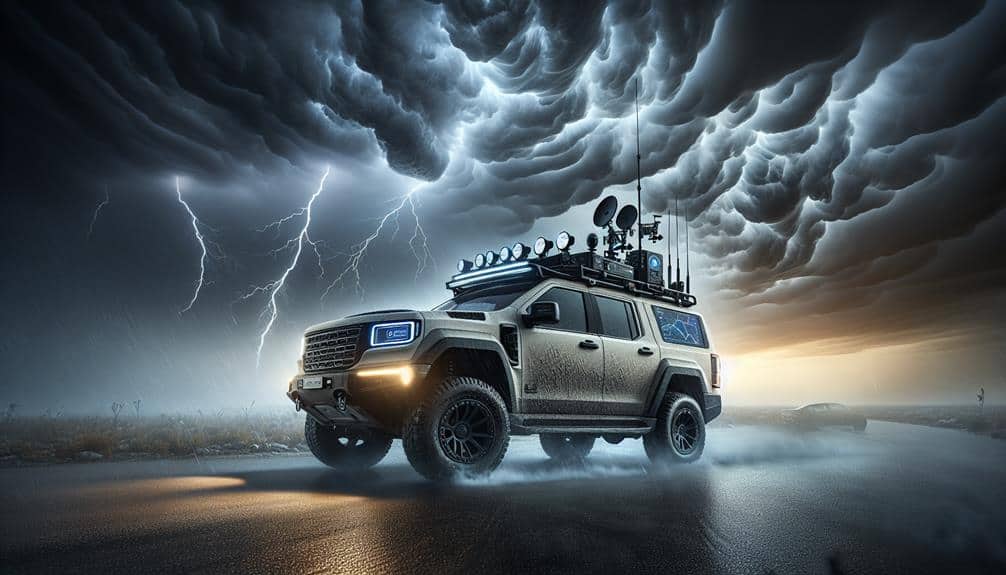
Equipped with durable protective clothing, we now turn our attention to high-performance vehicles that are essential for maneuvering and enduring the harsh conditions encountered in storm chasing. The best vehicle combines off-road capabilities and speed. An ideal choice is the all-wheel-drive SUV, which balances ruggedness with agility. These vehicles, when modified, can withstand the extreme environments we face.
Vehicle modifications greatly enhance durability. Reinforced suspensions guarantee the vehicle handles rough terrain without compromising stability. Additionally, skid plates protect the undercarriage from debris. High-performance tires with deep treads improve traction on muddy or uneven surfaces, while winches provide a reliable recovery option if we become stuck.
Speed is another vital factor. Turbocharged engines offer the necessary acceleration to keep pace with fast-moving storms. However, speed must be balanced with control; anti-lock braking systems (ABS) and electronic stability control (ESC) are essential for maintaining handling in adverse conditions.
For those of us dedicated to storm chasing, these vehicle specifications aren't just preferences—they're necessities. By investing in vehicles with robust off-road capabilities, speed, and essential modifications, we ensure not only our mobility but also our safety in the unpredictable elements of storm chasing.
Safety and First Aid Kits
Safety and preparedness are paramount, so our storm chasing kit must include a thorough first aid kit and essential safety tools. When we're out in the field, the unpredictable nature of storms necessitates rigorous adherence to safety protocols and the availability of detailed medical supplies. Our first aid kit should be fully equipped to handle various scenarios, ensuring we can address any immediate injuries and prevent further harm.
Key components of our safety and first aid kit should include:
- Detailed First Aid Kit: This includes bandages, antiseptics, gauze, scissors, tweezers, and adhesive tape. These basic items are vital for treating minor injuries and preventing infection.
- Emergency Preparedness Manual: A detailed guide on emergency procedures, injury prevention, and first aid techniques is necessary. This ensures everyone is aware of the correct steps to take during an emergency.
- Automated External Defibrillator (AED): In the event of cardiac arrest, an AED can be a life-saving device. It's important we understand how to operate it.
- Personal Protective Equipment (PPE): Helmets, gloves, and safety goggles protect us from debris and hazardous conditions.
Data Recording Equipment
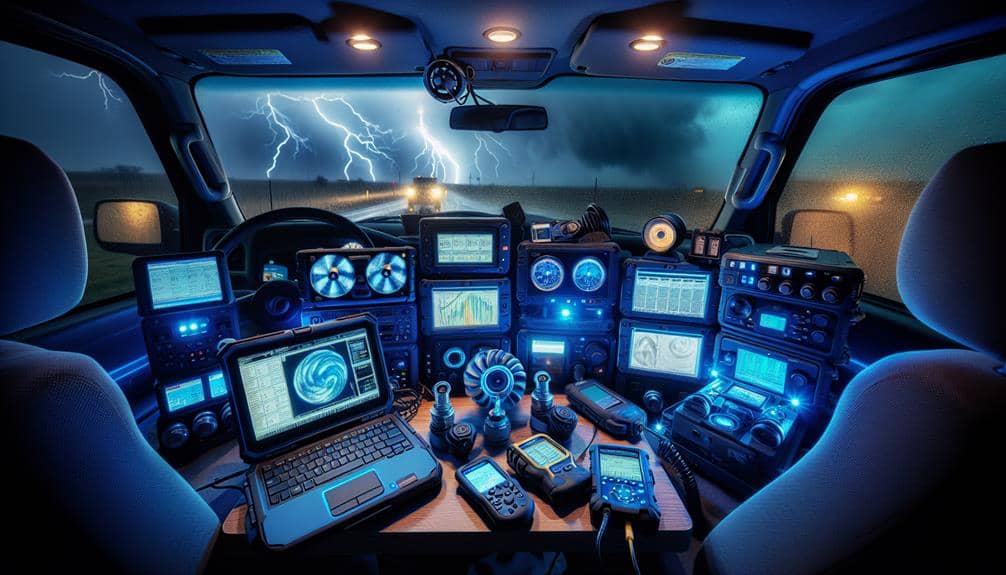
Accurate and reliable data recording equipment is vital for capturing the necessary meteorological information we need during our storm chasing missions. First and foremost, we rely on advanced weather instrumentation to record real-time data, which includes portable anemometers to measure wind speed and direction, barometers for atmospheric pressure, and hygrometers to assess humidity levels. These devices guarantee that we can monitor and analyze storm conditions with precision.
Moreover, integrating remote sensing technology is important for our operations. We use mobile Doppler radar systems to detect precipitation, wind patterns, and storm rotation from a distance. This remote sensing capability allows us to gather data on storm dynamics without putting ourselves in immediate danger. Additionally, ground-based remote sensors like LiDAR provide high-resolution data on atmospheric particles and cloud formations, enhancing our understanding of storm structures.
To store and process this data, we employ ruggedized laptops and tablets designed to withstand harsh weather conditions. These devices come equipped with specialized software for real-time data analysis and mapping.
Frequently Asked Questions
How Do I Become a Certified Storm Chaser?
To become certified storm chasers, we require storm chasing education and certification. We'll focus on chasing safety and preparation through specialized courses. These programs guarantee our comprehension of weather patterns, risk management, and proper equipment usage for safe pursuits.
What Are the Best Apps for Real-Time Storm Updates?
For real-time storm tracking and weather alerts, we recommend RadarScope, MyRadar, and Storm Shield. These apps provide precise, up-to-date data essential for storm chasing, ensuring we have the freedom to make informed decisions on the go.
How Can I Join a Storm Chasing Team?
To join a storm chasing team, we should focus on team dynamics and recruitment processes. We need to meet training and qualifications standards. Research teams that value freedom and initiative in their pursuit of storm data.
What Are the Legal Considerations for Storm Chasing?
Let's explore the truth: storm chasing requires understanding legalities. We must obtain liability insurance and comply with drone regulations to operate safely and legally. This guarantees our freedom to chase storms without facing significant legal consequences.
How Do I Maintain My Storm Chasing Equipment?
We maintain our storm chasing equipment by adhering to a strict maintenance schedule and conducting regular inspections. Proper equipment care, storage practices, and timely repairs guarantee our gear remains reliable and ready for the next chase.

